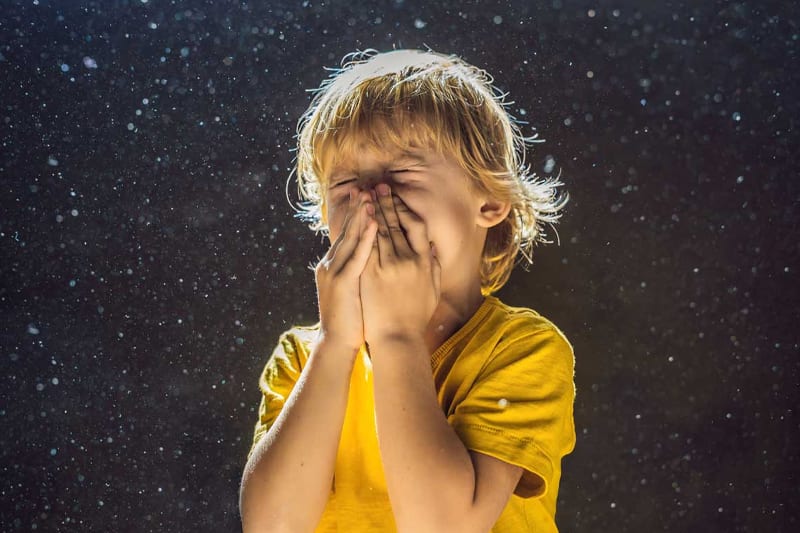There’s no place like home. For many of us, it’s where we are most relaxed and comfortable as the outdoor weather – warm or cold – is kept outside. But with modern improvements in building codes requirements, our homes have also become traps for air contaminants, including potentially dangerous carbon dioxide (CO2) levels. Having an air cleaning unit installed in your home’s ventilation system can considerably lower, and possibly eliminate, many of these contaminants.
Look around
Take a quick scan of your home. That dust collecting on end tables and shelves is only a fraction of what’s floating around in the air. The invisible mix of dust mites, pollen, mold, household cleaning solutions, secondhand smoke, building materials, beauty products, and CO2 build-up are all contaminants that affect breathing, and if levels are high enough, can cause headaches and tiredness plus other symptoms. The table below shows various CO2 levels and potential health problems associated with each:
| 250 – 350 ppm | Background (normal) outdoor air level. |
| 350 – 1,000 ppm | Typical level found in occupied spaces with good air exchange. |
| 1,000 – 2,000 ppm | Level associated with complaints of drowsiness and poor air. |
| 2,000 – 5,000 ppm | Level associated with headaches, sleepiness, and stagnant, stale, stuffy air; poor concentration, loss of attention, increased heart rate and slight nausea may also be present. |
| > 5,000 ppm | This indicates unusual air conditions where high levels of other gases also could be present. Toxicity or oxygen deprivation could occur. This is the permissible exposure limit for daily workplace exposures. |
| > 40,000 ppm | This level is immediately harmful due to oxygen deprivation. |
(ppm: parts per million)
So, where do I start?
A quality filter is perfect as the first line of defense against indoor air pollutants to keep our homes clean. An important next step includes adding an air cleaning unit, such as an electronic air cleaner, UV light treatment or humidifier to our furnace ductwork, which effectively cleans your indoor air of both visible and invisible air impurities. Here’s how the air purifiers work:
Electronic air cleaners
Electronic air cleaners, sometimes called ionizers, use electrically charged filters to reduce the number of airborne contaminants in your home. Before air from the furnace reaches the ductwork, it passes through the electronic air cleaner’s initial filter, which traps large particles (such as dust and dander). Then, the electrically charged filters attract and trap smaller particles (think bacteria and mold) to prevent them from recirculating through your home.
Plus, electronic air cleaners have easy-to-clean, reusable filters, which should be washed every few months, effectively reducing the need to purchase multiple filters.
Ultraviolet (UV) light air purification systems
When used as part of your home’s heating system, a UV light air purification system can purify the air throughout your entire home. Unlike other systems, the UV lights kill spores, bacteria and viruses rather than just trapping them. A UV light system also keeps objects, like air conditioning coils, free from mold buildup by killing the cells and preventing them from growing and spreading throughout your home. This system also removes odours in your home.
The resulting improvements in air quality can lessen allergic reactions and symptoms (while you are in your home), limit the spread of viruses and reduce breathing issues.
A filter is not an air purifier
Many homes use filters in the ventilation system to remove harmful particles from the air. Although a filter will help clean the air inside your home, many airborne contaminants are so fine that they pass through even the most efficient filters, much like using a tennis racket to strain sand. A UV air purifier is one of a few solutions that effectively reduces or eliminates these miniscule pollutants.
Humidifier
Too much or too little humidity also lowers the quality of air in our homes. With the change in seasons from warm to cold, the moisture levels in the air start to drop. This not only results in dryer skin, but without adequate moisture, our body’s immune system is unable to effectively defend against respiratory pollutants and irritants.
Saving you money
Proper relative humidity can also lower home energy costs. Humid summer air feels warmer than it is because of its moisture levels. That same principle applies to your home in the winter: maintaining an ideal indoor humidity level often means you can turn your thermostat down a bit and still feel comfortable. Keeping your home’s temperature just three degrees lower than you might typically during the cold season can reduce your heating bill by as much as five percent.
In addition to reducing your heating bill, proper relative humidity within your home can help reduce warping, shrinking and cracking of your wood flooring, furniture, and door and window frames. Click here to read more about residential humidifiers.
Why do we need an air treatment system in our homes?
With improvements to building codes, our homes have become cozy and fairly airtight. While this is great for energy-efficiency, it’s not so great when allergens, viruses, spores, pollens, mold and other contaminants, such as CO2, can no longer escape. Without the installation of an electronic air cleaner, UV light air purifier or humidifier to our furnace ductwork, these pollutants will continually circulate throughout your home, potentially causing breathing issues, headaches, tiredness and allergic reactions.
What are the next steps to improving the air quality in your home?
Give us a call at 780-449-5322 or email us at sandy@sherwoodmech.com to schedule an in-home ventilation inspection, including a reading of CO2 levels. Plus, we will let you know the best air cleaning solution (electronic, UV and humidifier) for your home. And in the meantime, we recommend taking these steps to help reduce indoor air irritants:
Use an exhaust fan in the kitchen, bath and laundry areas, if possible. Switch it on before preheating the oven or firing up the burners, and leave it running for a few minutes after you’re done cooking.
Minimize the use of candles or lighting wood fires.
Ban smoking inside the home.
Reduce the use of hazardous home cleaning solutions.









